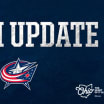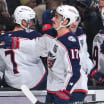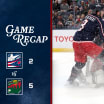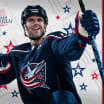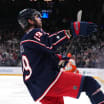As I stood in front of one of the nets in the OhioHealth Ice Haus, Kenny McCudden lined up three pucks about 25 feet out from the top of the crease.
I had already waved badly at nine shots fired at the net by the Blue Jackets assistant coach, an 0-for-9 showing that would have struck me out of an entire inning of baseball.
As McCudden got ready to take three more shots during our drill of tipping pucks in front of the net past an imaginary goalie, he laughed and had a warning.
"You miss all three of these," he said, "you have to skate."
McCudden's methods help get the best out of the Blue Jackets
What it's like to go on the ice with the ever-positive assistant coach
JacketsInsider trades his press pass for pads.
By
Jeffrey Svoboda @JacketsInsider / BlueJackets.com
So the pressure was on. Finally, after I flailed hopelessly at two more shots, McCudden fired one last chance and -- miraculously -- stick met puck and the latter flew into the netting. McCudden replied with a fist bump and a smile as I launched into an exaggerated celebration.
As you may have guessed, I'm no NHL player. As someone who picked up the game starting at age 28, you can find me skating on two D-level teams -- the second lowest of the four levels offered by the Chiller Adult Hockey League -- when I'm not covering Blue Jackets hockey.
It's done for fun and exercise and that occasional moment where I accomplish something mildly athletic. But after watching McCudden work with Columbus players and getting to know someone who is thought of as one of the hockey world's best skills coaches, I had an idea.
If McCudden can make an impact working with NHL-caliber players, improving their games with his unique approach, encouraging demeanor and relentless work ethic, what it be like for me to go through a practice with him?
"I love it," McCudden said when I approached him with this idea for a story, which is how I ended up on the ice wearing a Blue Jackets practice jersey one fall morning with the fifth-year coach.
Half an hour later, I was out of breath, covered in sweat, and armed with an understanding of why many of the world's best players swear by McCudden's methods.
On-ice education
When I say skills coach, it's easy to think of someone teaching a player how to rip a wrist shot into the top corner or how to dangle through multiple defenders with the puck on a string.
That's far from what McCudden does. His focus is on making hockey players better in game situations, and if you watch -- or partake in his instruction -- you can easily see how his drills will translate directly to the ice. For example, one drill McCudden had me do was to skate from the faceoff dot in the offensive zone to the corner, grab a puck, pass it to McCudden at the blue line, then skate immediately to the front of the net to receive a return pass and a goal-scoring opportunity.
At the NHL level, it's generally not fancy, but it's something players might be able to put into use seconds into their next competitive game. Fine-tuning it can be the essential difference between a successful play and one that goes by the wayside.
"You want to get in the fundamentals," McCudden said. "Instead of overskating a puck in the crease, a skill is hanging in there and whacking away at it until it goes over the goal line. That's a skill. A skill is not skating past the blue and going behind the net and taking a big skate. Skill work is not sending National Hockey League players in and out of cones."
He's a natural tinkerer with a curious mind that's always in motion. Away from the ice, McCudden collects antiques -- from
skates that are hundreds of years old
to sticks from hockey legends to golf clubs that date to the beginning years of the game -- and has created a number of contraptions to aid in his coaching. The metal "rebound deflector" that he built that allows pucks to mimic the path they take in games when they bounce off bodies or goalies in front of the net is often found on the ice at Blue Jackets practices.
That trait comes out in his work. Asked how many drills he has run over his lengthy career, McCudden replied that the answer is in the thousands, and they can all be found in notebooks the 58-year-old keeps from each season.
After each day of working with players, McCudden writes down the date of each drill, the players involved and the objective behind each, "then I file it and never look at it again the rest of my life," he says. That is, of course, unless a player or coach he's worked with wants to go back and recreate them, in which case he or she can have the exact drills delivered by McCudden.
When it comes to his work on a daily basis with Columbus, McCudden runs a session of about a half hour before each regularly scheduled Blue Jackets practice where any player who wants can join. Players can seek him out for specific work as well, and McCudden also works extensively with the team's healthy scratches and injured players to keep them game-ready.
"He does a great job of taking guys and maximizing what they already have and also focusing on some areas they can improve in," said captain Nick Foligno, who often works with McCudden before practice. "We've really enjoyed our time with him, and he's been a big addition to this team."
Then there's the offseason, when McCudden is in high demand from the pros. In addition to working regularly with players near his native Chicago, he travels across the country to hit the ice with others. On the Blue Jackets, forward Pierre-Luc Dubois and defenseman Zach Werenski are among those who have asked McCudden to spend time with them during summer workouts.
"He's like an encyclopedia of hockey drills," said Dubois, who has flown McCudden to his native Montreal for summer work. "He doesn't even need a sheet of paper or notes or anything. He just pulls them out of midair. And the thing I like the most is it's fast. You're three or four minutes and then you change right away to do something new.
"It keeps you fresh, and instead of just being bored, it's just constantly going so you're always concentrating. You have to because you know the drill is not going to last long and you want to do it the right way. That's what I like most about him."
Always a smile
If there's one thing that stood out about my time on the ice with McCudden, it's that he kept saying I was doing "awesome."
At one point I couldn't help myself, channeling Inigo Montoya from "The Princess Bride."
"You keep using that word, Kenny," I said as I struggled to complete drill after drill, "but I'm not sure it means what you think it means."
But if there's one thing McCudden brings to each session, it's a surplus of enthusiasm. Simply put, the man has no bad days when he laces on the skates and puts steel to ice.
"I have the same feeling today lacing up my skates in the National Hockey League as I did at 6 years old," he said. "I still love putting on my skates, and when you get to put on a sweatsuit at the highest level and you're wearing these blue colors right here and you have this logo on your chest, you realize you've been very fortunate to be looked at, trusted and hired to do the job."
Over the course of an 82-game NHL season -- with its ups, downs, constant travel, aches, pains and frustrations -- that's part of the beauty of his message.
"He's the most positive person ever, which I think is huge," Foligno said. "I think we need that. The other coaches and we as players get caught up in the magnitude of the situation, where he's able to just work on the player and coach the player. I think he really enjoys that."
That's especially true as McCudden works with players who are in and out of the lineup, waiting their turn to get back to playing NHL hockey on a regular basis.
"It's important," said Harrington, who has been a healthy scratch for much of the season as the team's seventh defenseman. "It can be frustrating when you're not playing. You want to be out there when it matters and compete and have fun and play with your teammates, and I think Kenny is the perfect person to keep things upbeat.
"It doesn't seem like he has bad days, and that's important when you're going through a tough time on the ice and he's there helping you alone."
A long road
Perhaps that enthusiasm comes from McCudden's own life and career in hockey.
McCudden grew up outside of Chicago, served as a stick boy with the Blackhawks in his younger days and played junior hockey as well. When the time came for a potential pro career, the Blackhawks suggested a spot on the Flint Generals of the IHL, which at the time was a "Slap Shot" style, Wild West league where punches were just as likely to be thrown as goals scored.
At 5-foot-8 and not exactly a brawler, McCudden knew that it wasn't the place for him to excel, but staying in the game was on his radar. He started as an assistant trainer with the Blackhawks, leading to a circuitous journey that has included coaching everyone from kids to pros - close to 125,000 players overall, and he's counted.
McCudden has been the owner of a Chicago-area hockey school, worked for years with the minor league Chicago Wolves, spent part of this decade with the U.S. Women's National Team program -- he's particularly close with the standout of last year's All-Star Game, Kendall Coyne Schofield -- and pitched in with various OHL and NHL teams over the years, always ready to run a drill.
When he was hired in 2015 by the Blue Jackets, he was believed to be the first full-time skills coach hired by an NHL team. His methods are built around skating and skills, and how the two interact to create a hockey player.
"You realize, 'What did you like when you played?'" McCudden said. "You like the fact that the puck was always around you. I always had a thing where I didn't want to just power skate players, whether they were kids or pros. You just can't. The game is played with a puck. Can you imagine throwing baseball players on the field with no ball? It just doesn't make sense to me at the end of the day. You can't mimic the game."
It's something I learned firsthand in my time on the ice. While McCudden quickly spent about five minutes of our time together instructing me on proper skating stance and form -- I didn't realize how little I was bending my knees or how much I was picking up my feet at the end of each stride -- most of the drills were puck-based.
Passing a puck and then getting to a spot for a return pass. Crashing the net but stopping outside the crease to receive a pass and drive the puck home. Establishing position in front and then tipping a puck past a goaltender.
At the end of the day, I skated off the ice not only having had fun but believing I was a better hockey player. That would likely be music to McCudden's ears.
"I'm really, really proud of coming prepared and dedicated every day, and letting the players see that," he said. "The biggest wonderful high I can get from being around this game and being so blessed and fortunate to be around this game is having the feedback from the players, knowing they enjoyed it, they got something done, their execution was there and we were productive for the day. That's when I know it's been a wonderful day in the game of hockey."



